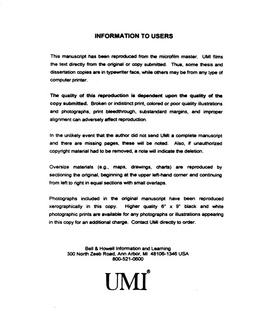| dc.contributor.advisor | Ashby, Michael T., | en_US |
| dc.contributor.author | Alguindigue, Susan Stanislav. | en_US |
| dc.date.accessioned | 2013-08-16T12:30:55Z | |
| dc.date.available | 2013-08-16T12:30:55Z | |
| dc.date.issued | 2000 | en_US |
| dc.identifier.uri | https://hdl.handle.net/11244/5968 | |
| dc.description.abstract | Metal complexes were synthesized with the atropisomeric dabp. X-ray crystal structures were solved for [Ru(bipy)2(dabp)]2+ and [(eta6-C6H6)Ru(dabp)(Cl)]+. Only one diastereomer was observed for [Ru(bipy)2(dabp)] 2+ in the 1H NMR spectrum. Exchange was observed and measured for the ruthenium and osmium complexes of [(eta6-C 6H6)M(dabp)(Cl)]+. | en_US |
| dc.description.abstract | [M(bipy)2(1,1'-biiq)]2+, [(eta6-C6H6)M(1,1'-biiq)(Cl)] +, [(eta6-C6H6)M(1,1 '-biiq)(I)]+ and [(eta6-C 6H6)M(dabp)(Cl)]+ (M = Ru, Os) are the only examples in the literature of third-row transition metal complexes having faster rates of atropisomerization than their second-row congegers. While the KEE varies among the 1,1'-biiq compounds, the KHE is nearly the same for each system. KHE may be a better indicator of the misdirected metal-ligand bond. | en_US |
| dc.description.abstract | A comparison of the rates of isomerization of the ruthenium and osmium derivatives of [M(bipy)2(1,1'-biiq)] 2+, [(eta6-C6H6)M(1,1 '-biiq), [(eta6-C6H6)M(1,1 '-biiq)(I)]+, and [(eta6-C 6H6)M(dabp)(Cl)]+ has led to the introduction of the term Kinetic Element Effect (KEE). The KEE is the ratio of the rates of isomerization reactions of second-row and third-row metal-ligand complexes (KEE = k2nd/k3rd). A Kinetic Enthalpy Effect (KHE) can be defined as the ratio of enthalpy of activation for the third row and second-row atropisomerization reactions (KHE = DeltaH‡ 3rd /DeltaH‡ 2nd). | en_US |
| dc.description.abstract | [(eta6-C6H6)M(1,1' -biiq)(X)]+ (M = Ru, Os; X = Cl, I) were synthesized. 1H NMR chemical shifts were assigned by 2D-COSY experiments. Exchange between enantiomers was observed by 2D-EXSY experiments. Rates of atropisomerization of the 1,1'-biiq ligand were measured for all four derivatives by NMR. Rates were found to be faster for the ruthenium derivatives than the osmium derivatives. | en_US |
| dc.description.abstract | A series of Cp2Zr(Cl)(SR) (R = Methyl, ethyl, iso -propyl, tert-butyl) have been synthesized. The ground-state conformation that is adopted by these d0 metal compounds represent a compromise between stabilizing Mdpi-Sppi interactions and destabilizing R-Cp steric contact. The thiolate ligands in such complexes are therefore misdirected. Rotational barriers (DeltaG‡ ) about the Zr-S bond have been measured by 1H NMR for the first time. For (R = Methyl, ethyl, and iso-propyl, the barriers are proportional to the steric demand of the ligand and the bond strength of the metal-sulfur bond. A much lower barrier was measured for R = tert-butyl. (Abstract shortened by UMI.) | en_US |
| dc.format.extent | xix, 204 leaves : | en_US |
| dc.subject | Molecular orbitals. | en_US |
| dc.subject | Ligand binding (Biochemistry) g | en_US |
| dc.subject | Crystal field theory. | en_US |
| dc.subject | Chemistry, Inorganic. | en_US |
| dc.title | Investigation of ligand misdirection using the kinetic element effect and the kinetic enthalpy effect. | en_US |
| dc.type | Thesis | en_US |
| dc.thesis.degree | Ph.D. | en_US |
| dc.thesis.degreeDiscipline | Department of Chemistry and Biochemistry | en_US |
| dc.note | Adviser: Michael T. Ashby. | en_US |
| dc.note | Source: Dissertation Abstracts International, Volume: 61-04, Section: B, page: 1942. | en_US |
| ou.identifier | (UMI)AAI9968105 | en_US |
| ou.group | College of Arts and Sciences::Department of Chemistry and Biochemistry | |
